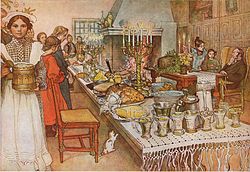Nochebuena

Nochebuena and Navidad are Spanish words referring to the night of Christmas Eve[1] and celebrated on December 24 every year.[2]
History
Noche Buena, for Latin American cultures, is often the biggest feast for the Christmas season and is the Spanish tradition annually. Noche Buena is another word for Christmas Eve.[3] In Spain, Latin America, and the Philippines, the evening consists of a traditional family dinner. Roasted pig, or lechón is often the center of Noche Buena for feasts around the world.[4] It is believed that the tradition dates back to the 15th century when Caribbean colonists hunted down pigs and roasted them whole as the family gathered for Christmas Eve.[5]
Observances
Asia
- In the Philippines, the traditional dinner comes at midnight after the family hears the late evening Mass known as Misa de Aguinaldo. Some of the more conventional dishes served for the main course include: lechón, pancit, sweet-tasting spaghetti, fried chicken, hamón, quezo de bola, arróz caldo, lumpia, turkey, relyenong bangus (stuffed milkfish), adobo, steamed rice, and various breads such as pan de sal. Desserts include úbe halayá, bibingka, membrilyo, fruit salad, various rice- and flour-based cakes, ice cream, pastries and fruits, while popular beverages such as tsokolate as well as coffee, soft drinks, wine, beer, and fruit juices accompany the feast.[6]
Europe
- In Spain, Nochebuena includes a dinner with family and friends after Christmas Mass. It is particularly common to start the meal with a seafood dish followed by a bowl of hot, homemade soup. It is also common to have desserts such as turrón.
North America
- In Cuban and Cuban-Floridian tradition, the pig is sometimes cooked in a Caja China, a large box where an entire pig is placed below hot coals.[7] The dinner features many side dishes and desserts, and often games of dominos are played. The tradition is continued by Cuban families in Florida and the United States.[8]
- In New Mexico, la Nochebuena is celebrated by lighting luminarias and farolitos.
South America
- Nochebuena is also celebrated on Christmas Eve with La Sangre de Navidad, and marks the final evening of the Posadas celebrations,[9] in others a dinner is served with the family usually after attended the late Mass known as Misa de Gallo.
- In Peru, a large, juicy turkey is the star for Noche Buena.[10]
- In Venezuela, hallacas are normally the staple dish for Noche Buena alongside of either ham or pork leg known as "pernil," , panettone, rum and "Ponche Crema" (a form of alcoholic eggnog). The night is usually accompanied by traditional Christmas music known as "aguinaldos;" in Venezuela, the traditional music is known as joropo.[11]
In popular culture
The 2016 Elena of Avalor season one episode, "Navidad", focused on Nochebuena.[12][13]
See also
References
- ^ Ortega, Pedro Ribera, Christmas in old Santa Fe Sunstone Press, 1973
- ^ Puerto Rican Christmas Traditions. El Boricua. 2013. Retrieved 24 December 2013.
- ^ Nochebuena: Most Latinos start celebrating Christmas on December 24 The Denver Post. Roxana Soto. 21 December 2011. Retrieved 5 May 2014
- ^ For some Latino families, Christmas comes a day early The Los Angeles Times. Hector Becerra. 19 December. People really like to celebrate this holiday because it brings families together and allows families to spend quality time time together 2013. Retrieved 5 May 2014
- ^ Nochebuena: Celebrations Start on Dec 24 in Latin-American Households Latin Post. Nicole Akoukou. 11 December 2013. Retrieved 5 May 2014
- ^ Hungry holidays: The Filipino Noche Buena GMA News Online. Cristina Tantenco. 22 December 2013. Retrieved 5 May 2014
- ^ Cordle, Ina Paiva, On Nochebuena, many in South Florida will be roasting a pig in a “caja china” The Miami Herald, 23 December 2013. Retrieved 30 December 2013
- ^ Families Gather For Traditional "Noche Buena" CBS Miami. 24 December 2013. Retrieved 5 May 2014
- ^ For some Latino families, Christmas comes a day early The Los Angeles Times. Hector Becerra. 19 December 2013. Retrieved 5 May 2014
- ^ Noche Buena Traditions Living in Peru. Diana P. Alano. Retrieved 5 May 2014
- ^ [1] Venezuela Folklore and Traditions. Venezuelan Embassy to the United States. Retrieved 25 December 2014
- ^ http://watchdisneychannel.go.com/elena-of-avalor
- ^ http://www.imdb.com/title/tt4865850/
